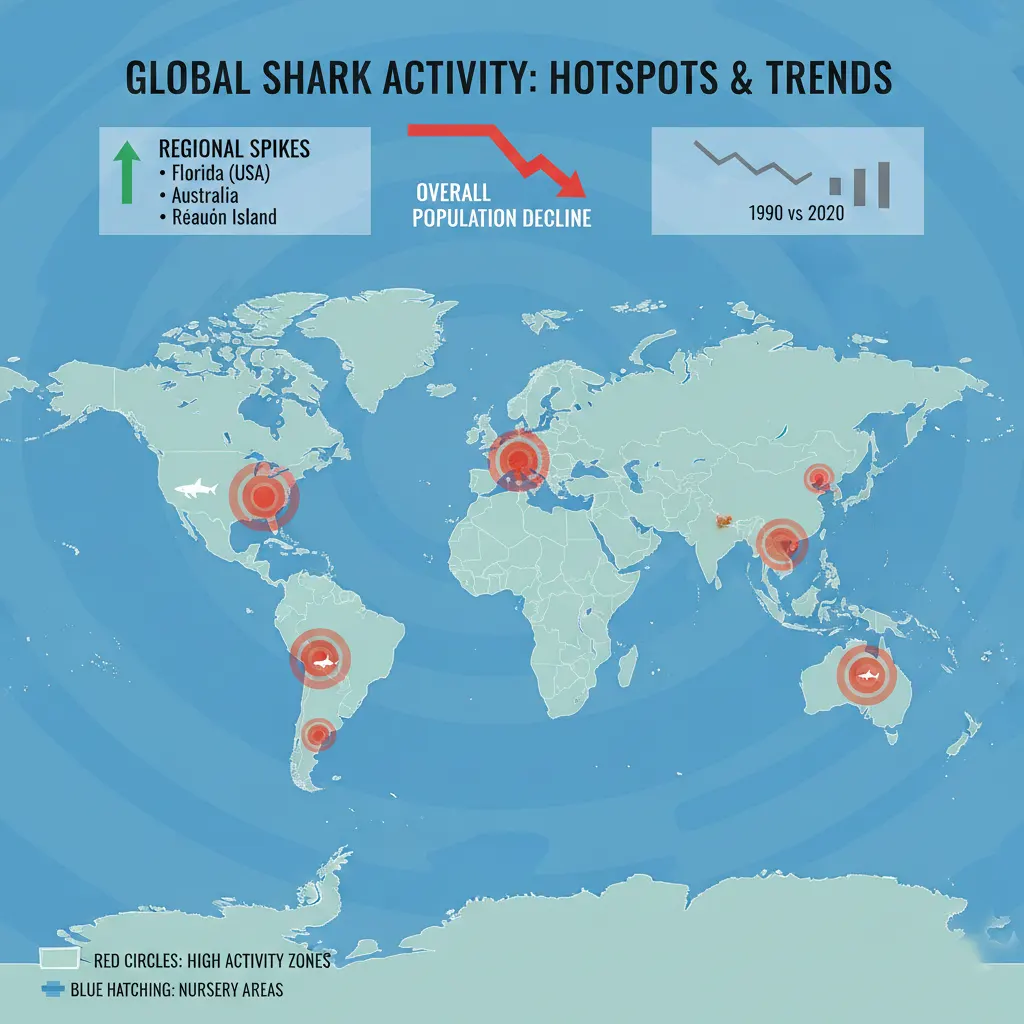The Surprising Truth: Shark Encounters Are Actually Declining
Despite the endless viral videos and alarming headlines splashed across social media feeds, the real scientific data shows a very different trend: global unprovoked shark bites have been declining, not increasing.
According to the International Shark Attack File, 2024 recorded 47 confirmed unprovoked shark bites worldwide, significantly below the five-year average of 64. This places 2024 among the lowest totals in recent years.
So why does the public perception suggest the opposite?
Three reasons:
- More humans in the water
- Better global reporting technology
- Instant worldwide amplification through social media
Rare events now travel faster, further, and louder than ever before.
Supporting climate-related changes are also documented by NOAA’s ocean warming research, which shows how environmental shifts can influence marine species—even when bite frequency remains low.

Breaking News: 2025 Shows Regional Spikes — Not a Global Trend
While overall global numbers remain low, 2025 has generated concerning regional spikes, particularly in fatal outcomes.
By late February 2025:
- 11 confirmed unprovoked attacks globally
- 5 fatalities
- Australia has reported 12 shark incidents by October
- 4 of those were fatal
The alarming part isn’t the number of encounters—it’s the unusually high mortality rate.
Australia’s Recent Tragedy: A Year of Deadly Incidents
In one of the most tragic incidents of 2025, a Swiss tourist was killed and another injured at Kylies Beach near Port Macquarie, about 350 km north of Sydney. Marine biologists confirmed a large bull shark was responsible.
This came only two months after a separate fatal attack at Long Reef Beach near Sydney, raising concerns among safety experts and policymakers.
Australia’s shark safety and tracking programs, including SharkSmart NSW and Surf Life Saving Australia, have been monitoring these trends closely.
Global Shark Hotspot Map: Where Humans & Sharks Interact Most
United States: Still #1 Globally — But Numbers Continue to Decline
The U.S. consistently records the highest number of unprovoked shark bites due to long coastlines, warmer waters, and heavy ocean recreation. Yet the numbers show improvement:
- 28 confirmed bites in 2024 (down from 36 in 2023)
- U.S. accounts for 60% of global incidents
- Lower severity compared to other nations
High-quality public reporting plays an important role in U.S. statistics.
Florida: The Long-Reigning “Shark Bite Capital”
Florida continues to lead the nation in shark encounters, with:
- 942 recorded bites since 1882
- 14 bites in 2024 (down nearly one-third from 2023)
- 0 fatalities in 2024
New Smyrna Beach in Volusia County holds the global record with 277 recorded bites over several centuries. Despite the reputation, Florida’s public safety programs and early-warning systems—supported by research from the Florida Museum’s Shark Research Program—have kept fatality rates very low.
Texas: The Rare South Padre Island Multi-Victim Event
Independence Day 2024 delivered an unprecedented event off South Padre Island, where four people were believed to be bitten by the same bull shark.
Key details:
- Shark estimated at 6 feet long
- Two victims required hospitalization
- One woman, Tabatha Sullivent, lost her left calf
- Shark dispersed into open waters shortly after
Multi-victim shark encounters of this type are extremely rare and remain one of the most unusual in Texas history.
California & Hawaii: Consistent Patterns Involving Great Whites
Both states reported stable, predictable patterns:
- California: 3 unprovoked bites in 2024
- Hawaii: 4 unprovoked bites in 2024
California’s encounters predominantly involve great white sharks. Research from the CSU Long Beach Shark Lab found that humans and sharks shared Southern California beaches on 97% of observed days between 2019–2021.

Australia: A Deadly Start to 2025
Australia historically sits behind the U.S. in shark encounter numbers. But in 2025, the country recorded a disturbing spike in fatalities:
2025 Fatalities by Region
- Queensland: 5 attacks, 1 fatal
- Western Australia: 3 attacks, 1 fatal
- New South Wales: 2 attacks, 1 fatal
- South Australia: 2 attacks, 1 fatal
This reverses the trend of zero fatalities in 2024, prompting scientists to re-examine regional environmental changes and prey movement.
Other Global Hotspots
Réunion Island
The Mascarene Islands have one of the highest fatality rates on Earth:
- 47 attacks
- 19 deaths
- ~50% fatality rate
This is tied to steep drop-offs, murky waters, and high tiger shark presence.
Israel
Israel experienced its first recorded fatal shark attack in modern history in June 2024 near Hadera, showing that emerging hotspots can appear even in low-incidence regions.
Why Shark Encounters Happen: What the Science Says
Marine researchers identify four major factors behind shark-human interactions:
1. More Humans Are Entering Coastal Waters
With 29% of the U.S. population living in coastal counties (per the U.S. Census Bureau), ocean recreation continues to increase. More swimmers naturally increase interaction probability—even when shark populations remain stable or decline.
2. Climate Change Is Reshaping Shark Migration Patterns
Ocean warming is redrawing historical shark migration maps. Research from NOAA Climate shows:
- Tiger sharks are migrating farther north
- Juvenile white sharks are moving closer to beaches
- Bull shark nurseries have expanded into North Carolina, once unseen this far north
These environmental changes bring sharks into new contact zones with humans.
3. Prey Distribution Is Moving With Warming Seas
Changes in temperature affect the entire marine food chain:
- Warmer waters reduce phytoplankton
- Prey fish relocate for food and temperature
- Sharks follow prey into shifting territories
Marine scientists from organizations such as the IUCN and Nature Research document these cascading ecological effects globally.
4. Most Shark Bites Stem From Mistaken Identity
Sharks rarely target humans deliberately. In most cases, bites involve juvenile sharks testing their environment.
Commonly involved species (2023–2024 data):
- Bull sharks — 15 attacks, 2 fatalities
- Tiger sharks — 11 attacks, 2 fatalities
- Great whites — 10 attacks, 2 fatalities
Murky water, splashing, and bait fish can create scenarios where sharks mistake limbs for prey.
The Economics of Fear: Tourism Takes a Hit
Even when nonfatal, shark incidents can cause substantial economic damage.
Example:
Following multiple attacks in Ballina, Australia in 2016:
- Businesses lost AU$2.5 million
- Broader community impact reached AU$4.5 million
Small coastal towns dependent on seasonal tourism are especially vulnerable to negative media coverage.
Risk vs. Reality: How Dangerous Are Shark Attacks?
Statistically, shark attacks remain incredibly rare:
- 1 in 4 million lifetime odds in the U.S.
- 1 in 28 million globally
You are far more likely to be injured by:
- Dogs
- ATVs
- Lightning
- Household accidents
The long-term data shows shark bites have decreased over the past decade, thanks to greater public awareness and improved ocean safety protocols.

Expert Safety Recommendations for 2025
These evidence-based tips are recommended by marine biologists, lifeguards, and ocean safety professionals:
- Swim in groups
- Avoid dawn & dusk
- Stay close to shore
- Remove shiny jewelry
- Avoid areas with bait fish
- Follow flagged warnings & local reports
For broader ocean safety guidelines, both the American Red Cross and NOAA Ocean Service provide public safety resources.
A Changing Ocean Environment
The 2024–2025 shark encounter data highlights a changing ocean:
- Global bites are declining
- Regional spikes highlight environmental shifts
- Climate change is altering shark migration
- Human coastal activity continues to grow
Sharks are not becoming more aggressive. They are simply adapting to rapidly changing ecosystems—just as we must adapt our understanding of their behavior.
With proper knowledge, awareness, and respect for marine environments, humans and sharks can continue to coexist in shared waters.
#SharkEncounters #SharkAttacks #MarineScience #OceanSafety #WildlifeResearch #ClimateImpact #SharkHotspots #FloridaBeaches #AustraliaNews #OceanLife #SharkFacts


